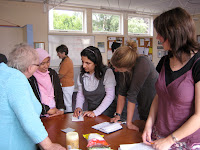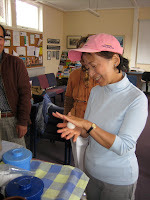Typical food for Chinese New Year is the Tang Yuan, a type of dumpling made from glutinous rice flour that is rolled into balls and stuffed with either sweet or spicy fillings such as sesame, red bean, or peanut butter paste. We made some of these in our conversation class.

Lysiane, Nik, Lily, Didi and Gwendoline write down the recipe for making Tang Yuan so that they can make some more at home.

Farah rolls a ball of glutinous rice before stuffing it and cooking it. Yuko watches her before.......

she rolls one of her own.

Zul is obviously enjoying rolling his Tang Yuan. I wonder what he will stuff his with - will it be sweet or spicy ?

Mike carefully watches how James rolls his Tang Yuan. James concentrates as he makes his dumpling.

Mike is the chief cook and he puts the Tang Yuan into boiling water - when the dumplings float up to the top of the water, they are cooked and need to be taken out.

Chetna watches carefully so that she learns what to do and next time she can become a cook and help Mike with his cooking task.
 Proud makers of Tang Yuan - Chinese New Year dumplings. Ready to serve and eat. They look very good for a first effort!
Proud makers of Tang Yuan - Chinese New Year dumplings. Ready to serve and eat. They look very good for a first effort!
James suggests that Mr McKenzie should be the first to try one of the Tang Yuan made by the group.

What does he think of the Tang Yuan? Can you guess from his expression or is the glutinous rice too sticky ?




















 irds could easily peck it.
irds could easily peck it.



















